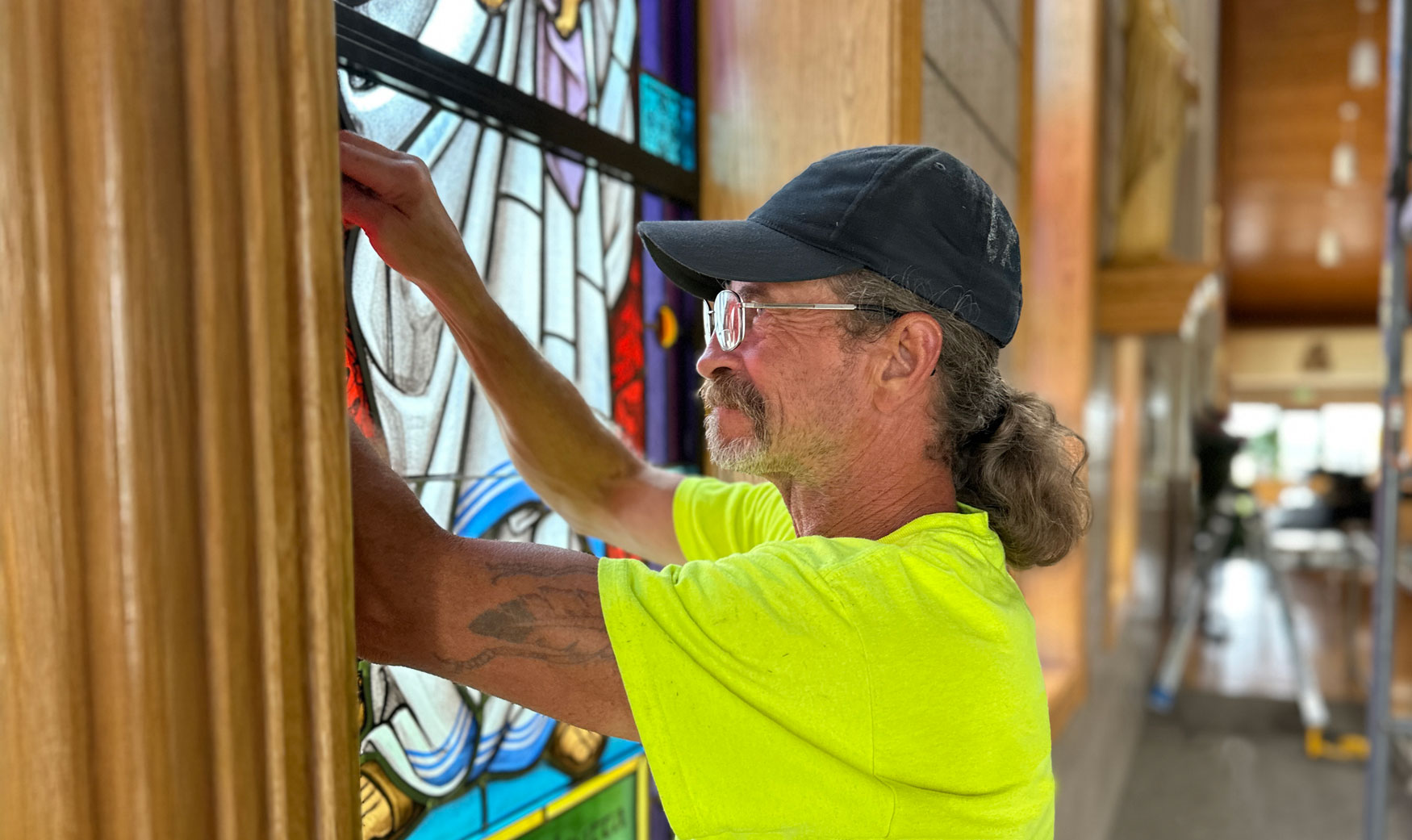
Stained glass windows hold incredible beauty and historical significance, often serving as the heart of many churches.
These intricate works of art not only elevate the aesthetic of a place of worship but also reflect its rich heritage and spiritual stories. However, as time takes its toll, these beautiful stained glass windows may lose their luster, suffer damage, or require restoration to preserve their legacy for future generations.
This guide will walk you through everything you need to know about church stained glass restoration – from understanding their history and significance to choosing a trustworthy restoration service.
By the end, you’ll have a solid understanding of the process and know exactly where to turn to restore and protect your church’s stained glass windows.
The History and Significance of Stained Glass
Stained glass windows have a rich and fascinating history that intertwines art, religion, and culture. Emerging prominently in the 10th and 11th centuries, these windows became a hallmark of Gothic architecture, gracing the towering cathedrals of Europe with their vibrant hues and storytelling prominence. The glass was carefully crafted using a combination of metal oxides to create vivid pigments, complemented by skilled artisans who assembled intricate scenes depicting biblical narratives, saints, and moral lessons. These works of art were not only functional, allowing light to stream through in myriad colors, but also symbolic – representing divine illumination and the presence of God within the sacred space.
Beyond their theological role, stained glass windows served a crucial educational purpose during the Middle Ages. At a time when literacy was sparse, particularly among common people, these windows became a form of “visual scripture,” conveying complex religious themes through imagery. The depictions were painstakingly detailed, ensuring that even those unfamiliar with written text could understand the messages of faith and morality embedded within the art.
Over time, the significance of stained glass windows expanded, reflecting the values and aspirations of the community that created them. They became vehicles for honoring benefactors, celebrating local saints, and commemorating pivotal moments in a church’s history. Today, these windows continue to be cherished not only for their breathtaking beauty but also for their ability to connect generations, serving as enduring symbols of faith, creativity, and heritage. Preserving these treasures through stained glass restoration is about more than maintaining a building’s appearance – it’s about safeguarding the legacy of countless stories, traditions, and spiritual expressions that they encapsulate.
Types of Stained Glass
Church stained glass comes in several styles, including traditional leaded glass, faceted glass, and painted stained glass. Each type has unique features that make it visually striking and requires specific techniques for repair and restoration.
Leaded Stained Glass
This classic style uses lead cames to join pieces of glass, creating intricate designs. Recognized for its timeless aesthetic, leaded stained glass has been widely used in churches for centuries. The lead framework not only provides strength and flexibility to support the design but also allows artisans to assemble glass pieces with precision, resulting in highly detailed and striking imagery. Over time, however, the lead can weaken because of age, exposure to the elements, or structural stress. Restoration of leaded stained glass involves carefully removing the panels, assessing the condition of the lead cames, and either reinforcing or replacing them. Each piece of glass must be thoroughly cleaned and reassembled with precision to maintain its artistic and structural integrity. This meticulous stained glass restoration process ensures the window retains its original craftsmanship while being equipped to last for decades to come.
Faceted Glass
Made of thick, colored glass, faceted panels offer a bold and textured appearance. Unlike traditional leaded stained glass, faceted glass involves embedding thick pieces of glass into an epoxy resin or concrete matrix. This technique creates a modern, sculptural look with rich, jewel-like colors that interact with light in striking ways. Faceted glass is often chosen for its durability and visual impact, making it particularly suited for contemporary churches or as an accent to more traditional designs. However, restoration of faceted stained glass requires specialized care because of the nature of its construction. The resin or cement may degrade over time, leading to cracks, loosening of the glass pieces, or loss of structural integrity. This type of stained glass restoration often involves carefully disassembling the panels, cleaning or replacing the thick glass segments, and reinforcing the matrix to ensure stability while preserving the vibrant, textural beauty that defines faceted glass windows.
Painted Glass
Incorporating hand-painted details, painted glass is often seen in older windows depicting biblical figures or intricate symbols. This style is celebrated for its artistry and the depth of detail it brings to stained glass windows. Artisans carefully paint designs onto the surface of the glass using specialized pigments, which are then fired in a kiln to fuse the paint into the glass permanently. This process allows for fine shading, delicate lines, and intricate imagery that can convey emotion, motion, and nuance in ways other styles cannot. Painted glass is commonly used to depict saints, biblical scenes, or elaborate patterns, offering a level of storytelling and personalization that makes each piece unique. Over time, however, the painted details can fade or deteriorate because of environmental factors such as UV light, moisture, and pollution. Restoration of painted glass involves cleaning the panels delicately, reapplying missing or damaged painting where necessary, and resealing the pieces within new or reinforced lead cames. This painstaking process ensures that the original beauty and historical significance of the glass are preserved, allowing these masterpieces to continue inspiring awe for generations.
Understanding the type of stained glass in your church is crucial when deciding on the right restoration approach.
Common Issues with Church Stained Glass
Stained glass windows endure considerable wear and tear over time because of environmental factors, natural aging, and occasional mishandling. Here are some common issues that may signal the need for restoration:
- Cracks and Breaks: Pieces of glass may crack or loosen over time.
- Bowed or Weakened Panels: Age and structural stress can cause windows to bow or warp.
- Oxidation or Corrosion: Lead cames and support structures might corrode, weakening the integrity of the window.
- Improper Previous Repairs: Amateur repairs can exacerbate damage or detract from the window’s original design.
Choosing a Company for Your Stained Glass Restoration Project
Choosing the right stained glass restoration studio is vital to ensure your windows are preserved with care, artistry, and precision. Here’s what to look for when selecting a repair shop.
Credentials and Experience
Work with experts who specialize in stained glass restoration. The team should have years of hands-on experience and an understanding of both historic and modern restoration techniques. A reputable studio, such as Willet Stained Glass Studios, will have decades (or in our case, more than a century!) of proven expertise.
Services Offered
Look for a shop that offers a comprehensive range of stained glass restoration services, including inspection, restoration, preservation, and custom design. This indicates the team’s ability to handle all aspects of the project and ensure long-term care for your windows.
Reputation and Reviews
Seek out stained glass restoration studios with glowing testimonials and a history of satisfied clients. Positive customer feedback reflects their commitment to quality, communication, and professionalism.
Willet Stained Glass Studios: A Legacy of Excellence
A Rich History of Craftsmanship
Willet Stained Glass Studios has been a trusted name in the stained glass world since 1898, serving more than 36,000 buildings. Our unmatched legacy combines time-honored artistry and modern techniques, ensuring each stained glass restoration project is both respectful of history and forward-thinking.
What Sets Willet Apart?
Willet offers more than just stained glass restoration services – we provide an opportunity to protect and elevate the beauty of your church. Here’s what makes us unique:
- 125+ Years of Expertise
- Customer-Centric Approach with free inspections, appraisals, and a 10-year warranty
- Energy Efficiency Solutions through professionally installed protective coverings that enhance longevity and save costs
- Dedicated Artisan Team to ensure meticulous craftsmanship
Comprehensive Services by Willet
- Restoration: From repairing cracks to replacing damaged sections, Willet’s skilled artisans tackle even the most intricate stained glass restoration projects. We preserve the details and integrity of your stained glass while enhancing its brilliance.
- Preservation: Willet doesn’t just restore your windows – we preserve them. We implement protective measures such as vandal-proof coverings and structural reinforcements, ensuring your windows remain intact for generations.
- New Designs: Looking for something fresh? Willet works hand-in-hand with clients to design and fabricate custom windows. With a focus on style, themes, and colors tailored to your needs, we ensure each window is a masterpiece.
Partner with Willet to Revitalize Your Church
The restoration and preservation of stained glass windows is more than an aesthetic
decision – it’s a commitment to honoring your church’s heritage, creating a light-filled sanctuary, and keeping its stories alive for generations to come.
If your church’s windows are showing signs of wear, don’t wait any longer. Contact Willet Stained Glass Studios today for a free inspection and consultation. With 125 years of experience in stained glass restoration and a passion for excellence, we’re the trusted partner you need.







